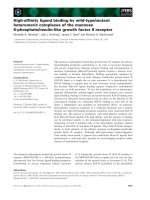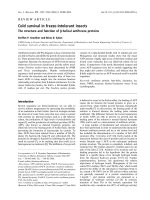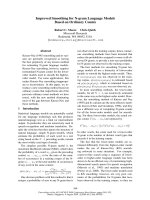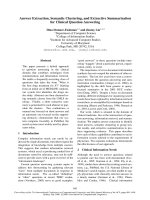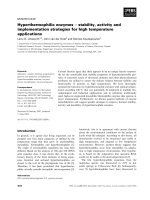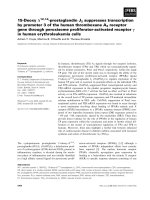Báo cáo khoa học: "Improved survival following surgery and radiation therapy for olfactory neuroblastoma: analysis of the SEER database" pdf
Bạn đang xem bản rút gọn của tài liệu. Xem và tải ngay bản đầy đủ của tài liệu tại đây (261.4 KB, 7 trang )
RESEARCH Open Access
Improved survival following surgery and radiation
therapy for olfactory neuroblastoma: analysis of
the SEER database
Mary E Platek
1*
, Mihai Merzianu
2
, Terry L Mashtare
3
, Saurin R Popat
4
, Nestor R Rigual
4
, Graham W Warren
5
and
Anurag K Singh
5
Abstract
Background: Olfactory Neuroblastoma is a rare malignant tumor of the olfactory tract. Reports in the literature
comparing treatment modal ities for this tumor are limited.
Methods: The SEER database (1973-2006) was queried by diagnosis code to identify patients with Olfactory
Neuroblastoma. Kaplan-Meier was used to estimate survival distributions based on treatment modality. Differences
in survival distributions were determined by the log-rank test. A Cox multiple regression analysis was then
performed using treatment, race, SEER historic stage, sex, age at diagnosis, year at diagnosis and SEER geographic
registry.
Results: A total of 511 Olfactory Neuroblastoma cases were reported. Five year overall survival, stratified by
treatment modality was: 73% for surgery with radiotherapy, 68% for surgery only, 35% for radiotherapy only, and
26% for neither surgery nor radiotherapy. There was a significant difference in overall survival between the four
treatment groups (p < 0.01). At ten years, overal l survival stratified by treatment modality and stage, there was no
significant improvement in survival with the addition of radiation to surgery.
Conclusions: Best survival results were obtained for surgery with radiotherapy.
Background
Olfactory neuroblastoma (ONB) or esthesioneuroblas-
toma is an uncommon neuroendocrine malignancy
which was first described by Berger et al. in 1924 [1].
ONB accounts for approximately 3% of endonasal neo-
plasms [2]. Though the etiology is unknown[2], ONB
appears to arise from the olfactory membrane of the
sinonasal tract and prefere ntially involves the anatomic
distribution of the epithelium overlying the cribriform
plate[2], superior turbinate and the superior nasal sep-
tum [3]. Patient s most commonly present with nonspe-
cific symptoms of nasal obstruction and epistaxis [2].
Less common symptoms include headache, pain, visual
disturbances and anosmia [2]. ONB affe cts both sexes
equally with a bimodal age distribution (the 2
nd
and 6
th
decades of life) although patients of all ages can be
affected [2].
The rarity of ONB has limited study to individual case
reports [4-8], small series [9-15], meta-analysis of such
small series[16], o r registry reports [17] and precluded
prospective trials. Based on such limited data, the gold
standard of care for these tumors is craniofacial resec-
tion followed by adjuvant radiotherapy [10,18,19].
The Surveillance, Epidemiology, and End Results
(SEER) database, which collects cancer incidence and
survival data from cancer registries that are population-
based and cover approximately 26% of the United States
population [20], was used to identify a large series of
patients with ONB. In a prior report of th e SEER data-
base, Jethanamest et al. were unable to show a signifi-
cant improvement in overall survival with the addition
of radiation to surgery [17]. The objective of this study
was to re-assess survival outcomes between different
treatment modalities among the ONB cases identified
* Correspondence:
1
Division of Cancer Prevention and Population Sciences, Roswell Park Cancer
Institute, Buffalo, New York, USA
Full list of author information is available at the end of the article
Platek et al . Radiation Oncology 2011, 6:41
/>© 2011 Platek et al; licensee BioMed Central Ltd. This is an Open Access article distributed under the terms of the Creative Commons
Attribution License ( which permits unrestricted use, distribution, and reproduction in
any medium, provid ed the original work is properly cited.
from the S EER database with an additional four years of
data.
Methods
Identification of Cases
The SEER database for the years 1973 to 2006 was used
to examine management strategies for ONB. The diag-
nosiscodeof9522/3wasqueriedandallrecordswere
found in the following sties: C30.0 (nasal cavity), C31.0
(maxillary sinus), C31.1 (ethmoid sinus), C31.2 (frontal
sinus), C31.3 (sphenoid sinus), C31.8 (overlapping lesion
of accessory sinuses) and C31.9 (accessory sinus, NOS).
Information for the following treatm ent groups was
queried: both surgery and radiotherapy, surgery only,
radiotherapy only, neither surgery nor radiotherapy. Sta-
ging in the SEER d ata is based on classification criteria
that vary by site and year of diagnosis. The SEER his-
toric staging variable provided information for the fol-
lowing categories: localized, regional, distant and
unstaged. Information for type, timing, and duration of
chemotherapy was not available from the SEER data-
base. The neuroepithelioma code, 9523/3, was also quer-
ied but there were no cases identified using this code.
Statistical Analysis
Treatment group information was summarized using fre-
quenci es and cumulative fr equencies. The Kaplan-Meier
method was used to estimate overall survival distributions
by treatment modality. A Cox multiple regression analysis
was performed using treatment, race, SEER historic stage,
sex, age at diagnosis, year at diagnosis and SEER geo-
graphic registry. Overall survival was then estimated by
stagecomparingsurgeryonlyversussurgerywithradio-
therapy for local stage, regional stage and for local plus
regional. These analyses were truncated for a nyone with
overall survival greater than 10 years. Statistica l assess-
ment of observed differences in survival distributions was
done using the log-rank test in conjunction with a Bonfer-
roni adjustment for multiple comparisons. A 0.05 nominal
significance level was used in all hy poth esis testing. Data
analyses were performed using SAS, version 9.1.3, statisti-
cal software (SAS Institute., Cary, NC).
Results
A total of 511 cases of ONB were reported for the years
1973 to 2006. A description of this cohort can be found
in Table 1. There was a unimodal distribution of ages
with most cases between the ages of 40 and 70 years old
(mean age was 53 years, SD of 18). The majority of
cases were treated with both surgery and radiotherapy
(61%), were whit e with 55% male and a primary tumor
site in the nasal cavity. Informat ion concerning whether
radiation therapy was administered before or after sur-
gery was not available. Approximately 22% of the cases
received surgery only, 11% received radiation therapy
alone and approximately 6% did not receive surgery or
radiotherapy. The distribution of treatment methods
and outcomes among the 511 cases is shown in Table 2.
There was a statistically significant difference in the
overall survival between these four treatment groups
(surgery and radiotherapy, surgery only, radiotherapy
only, and neither surgery nor radiotherapy) (p < 0.01).
The percentage of cases surviving five years by treat-
ment modality was: 73% for surgery and radiotherapy,
68% for surgery only, 35% for radiotherapy only and
26% for neither radiotherapy nor surgery.
Pair-wise comparisons demonstrated a statistically sig-
nificant difference in the overall survival distributions
between four of the pairs. The over all survival distribu-
tion between patients who received both surgery and
radiotherapy was significantly different from patients
who received radiotherapy only (p < 0.01) and from
Table 1 Description of SEER ONB cohort (N = 511)
Characteristic Frequency Percent
Age (years)
(n = 485)
<25 38 8
25-39 59 12
40-69 299 62
>70 89 18
Gender
Male 283 55
Female 228 45
Race
White 415 81
Black 41 8
Other 51 10
Unknown 41
Primary Tumor Site
Nasal Cavity 370 72
Maxillary sinus 22 4
Ethmoid Sinus 65 13
OthSinus (frontal, sphenoid accessory
sinuses)
54 11
SEER Historic Stage
(n = 473)
Localized 112 24
Regional 210 44
Distant 129 27
Unstaged 22 5
Treatment
(n = 485)
Both Surgery and Radiation 296 61
Surgery Only 105 22
Radiation Only 53 11
Neither Surgery Nor Radiation 31 6
Platek et al . Radiation Oncology 2011, 6:41
/>Page 2 of 7
patients who received neither surgery nor radiotherapy
(p < 0.01). Additionally, the overall survival distribution
between patients who received surgery only was signifi-
cantly different fro m patients who received neither sur-
gery nor radiotherapy (p = 0.03 ) and from patients who
received radiotherapy only (p = 0.046) All other com-
parisons were not significa ntly different. Figure 1 shows
overall survival curves stratified by treatment groups.
Cox multiple regression analysis was performed to
adj ust for interaction between covariates and confirmed
that treatment remained a significant predictor of over-
all survival (p < 0.01). Howe ver, the overall survival
distribution between patients who received surgery only
was no longer significantly different from patients who
received radiotherapy only (p = 0.13).
Estimated ten year overall survival comparing surgery
only versus surgery with radiotherapy stratified by local
stage, regional stage and local plus regional stage
showed no difference between these treatment methods
for any stage.
Discussion
This analysis of the SEER database represents the largest
published series of ONB cases. Five year overall survival
Table 2 Distribution of Treatment Methods and Outcomes for SEER ONB
Treatment Total
n = 485*
N (%)
Number Failed Number Censored Median Estimate (months)
Both Surgery and Radiotherapy 296 (61.0) 109 187 150
Surgery Only 105 (21.7) 41 64 169
Radiotherapy Only 53 (10.9) 30 23 39
Neither Surgery nor Radiotherapy 31 (6.4) 18 13 10
*26 cases with either surgery and/or radiotherapy information missing
Figure 1 Overall Survival of SEER ONB Cases by Treatment Groups.
Platek et al . Radiation Oncology 2011, 6:41
/>Page 3 of 7
stratified by treatment was: 73% for surgery and radio-
therapy, 68% for surgery only, 35% for radiotherapy
only, and 26% for neither surgery nor radiotherapy.
There was a significant difference in overall survival
between the four treatment groups (p < 0.01). There
was a significant difference in five year overall survival
distributions between patients receiving surgery and
radiotherapy and patients receiving radiotherapy only
(p < 0.01).
Of note, only 31 patients received “neither surgery nor
radiotherapy.” Based on historic staging information
from the SEER database, 84% of these patients had
region al or distant disease. The lack of a significant sur-
vival benefit compared with surgery alone or surgery
with radiotherapy is likely an artifact of these small
numbers.
Based on five year survival stratified by treatment and
consistent with one meta-analysis, smaller series and a
previo us examination of the SEER database, this analysis
of SEER data shows that surgery with radiotherapy
provides optimal management for ONB [9,10,16,17].
Jethanamest et a l. analyzed the SEER database from
1973-2002, identified 311 eligible patients, and reported
longest duration of mean survival was for cases receiving
both s urgery and radiother apy but also reported that th e
only significant differences between treatment groups
was for those receiving rad iotherapy alone and those
receiving combined modality treatment [17]. The authors
also performed a detailed analysis in which they
attempted to infer the patients’ Kadish stage from the
information available in the SEER database. Such an ana-
lysis, lacking any clinical or radiologic basis, has obvious
limitations which were ably enumerated by the authors
in their discussion. Due to these limitations, we did not
make an effort to repeat inference of the Kadish stage.
Dulguerov et al. performed a meta-analysis of ONB
publications between 1990 and 2000 (26 studies, 390
patients) with the objective to review recent develop-
ments in diagnosis, staging and treatment [16]. The
optimal approach to treatment in this meta-analysis was
a combination of surgery and radiotherap y. Gruber et al.
and Lund et al. concluded the same (Table 3) [9,10].
Radical surgery, however, of early stage lesions is not
performed at all centers [4], and there are reports that
endonasal endoscopic resection and postoperative adju-
vant radiotherapy yields comparable outcomes to o pen
craniofacial resection and adjuvant radiation therapy
[18,21-23]. The advantage o f sample size in this SEER
analysis, while a distinct benefit in comparison to smal -
ler single institution series, does come at the cost of lim-
ited documentation of treatment detail. For example, the
SEER database did not include type of surgical resection.
In a recent meta-analysis of patient data for ONB
between 1992 and 2008, endoscopic surgery was shown
to be a valid treatment method to open surgery [24].
This SEER analysis is not able to discriminate any
potential differences in outcomes with open craniofacial
versus endoscopic resection. Additionally, the time per-
iod for the SEER database, 1973-2006, includes a time
period before the beginning of the modern a ge of skull
base surgery (1985-1990). A st ratifi cation of patient sur-
vival by year o f diagnosis may facilitate understanding if
current treatment paradigms are better than prior ones
and particularly for surgical procedure, but the limited
numbers even in this cohort would make any conclu-
sions based on stratified analyses untenable. We did
include y ear at di agnosis as a covariate in our Cox
regression model.
The Role of Chemotherapy
The SEER database did not include information for
those treated with chemotherapy, however recent
reports of outcomes for ONB patients have included
chemotherapy [11-15]. These findings a re summarized
in Table 3.
Selection Bias: A Major Limitation of Any Retrospective
Review
Selection bias, which confounds any retrospective
review, is particularly relevant in this analysis whe n
comparing the surgery only and surgery plus radiation
groups. This bias exists because clinicians treating the
patients whose data is captured in the SEER database
made decisions to give o r omit radiation following sur-
gery often based on clinical/pathologic/radiographic
information that is not captured by SEER. Thus, one
suspects that patients given surgery and radiation had
poorer prognostic factors than those who received sur-
gery alon e. The absence of a statistically signifi cant sur-
vival benefit with the a ddition of radiation must be
interpreted within the context of this possible selection
bias. In this analysis, we examined ten year survival by
stage (local, regional and local plus regional) for surgery
compa red to surger y with radiotherapy and did not find
a statistically significant difference for any stage.
Other Limitations of the SEER Database: Pathologic,
Terminology, Taxonomy, Grading and Staging
Considerations
ONB is a tumor restricted to the area of olfactory neu-
roepithelium, which arises from embryonic olfactory pla-
codes and in adults is replaced partially by respiratory
mucosa. Not surprisingly in a tumor arising from the
neural-epithelial olfactory mucosa, the phenotype of
ONB is intermediate between that of pure neural neo-
plasms (neuroblastoma and paraganglioma) and neu-
roendocrine epithelial tumors (carcinoid, neuroendocrine
carcinoma, small cell carcinoma) [25]. This intrinsic
Platek et al . Radiation Oncology 2011, 6:41
/>Page 4 of 7
heterogeneity accounts fo r the various synonyms used to
describe this neoplasm in the past: esthesioneuroblas-
toma, esthesioneuroepithelioma, (esthesio)neurocytoma,
and even neuroendocrine carcinoma [26]. Due to its ana-
tomic location, ONB is diagnosed in clinical practice by
general surgical/head and neck pathologists and/or neu-
ropathologists (depending on the surgical approach) who
might use a slightly different terminology, as illustrated
by the respective ONB description in the two corre-
sponding WHO tumor classifications [2,25].
In addition, pathologic ONB definition has been
refined in the period studied from being based exclusively
on histomorphology [27-29] to include ultramicroscopic
findings [26,29-33] and immunoprofile[2,25,32,34-36] in
the diagnostic process. Regardless, it is worth noting that
most ONB occurring in their characteristic location are
easily recognizable, especially on the low grade side of
the spectrum, which account for most cases reported in
other series and (presumably) for the tumors reported to
SEER database.
The only grading system available for ONB is unchanged
from 1988 when Hyams proposed it based on the Armed
Forces Institute of Pathology experience [37]. This system
divides the ONB into four grades ranging from well (I) to
least differentiated (IV) based on the tumor archit ecture,
cellular pleomorphism, presence of neurofibrillary matrix
and rosettes, mitotic activity, and presence of necrosis or
calcifications . The grading system is somewhat subjective
and sampling dependent (absent a complete resection) and
its reproducibility is difficult to estimate due to the rarity of
this disease.
The clinical staging introduced by Kadish a decade
earlier describes mostly tumors of low Hyams grade
[28]. A revised Kadish staging system which describes a
stage D tumor as consisting of cervical or distant metas-
tases was proposed by Morita [38]. In an analysis of sur-
vival and prognostic factors, Jethanamest et al. applied
the modified Kadish staging system to 261 cases of
esthesioneuroblastoma from the SEER database [17].
Cox regression analysis results showed that the staging
system was a significant predictor of disease specific sur-
vival [17]. Other staging systems, based on the TNM
staging system, have been proposed by Biller and
Dulguerov [39,40].
Without the benefit of a centralized pathology review
we cannot stratify this SEER case series based on tumor
grade; however the existing published experience and
the above diagnostic considerations would support a
bias toward low grade ONB reported to the SEER data-
base [28,40] although in some studies low and h igh
grade tumors were evenly distributed without affecting
the outcome [15].
Table 3 Summary of Published Single Institution Experiences
Study Year Institution Period No. of patients
(f/u in months)
Treatment
Received
Findings
Gruber et al.
[9]
2002 Universities of Berne and
Zurich
1980-
2001
28 (68) Group 1: S
(radical) + RT
Group 2: S(partial)
+RT
10 year DFS:
Group 1: 55%
Group 2: 0%
Lund et al.
[10]
2003 University College London 1978-
2001
45 (57) Group 1: S alone
Group 2: S + RT
Local Recurrence
Group 1: 28%
Group 2: 8%
Studies Including Chemotherapy
Rastogi et al.
[11]
2006 King George Medical
University
1988-
2004
8 (36) All Patients:
S (NCFR) + RT + C
3 year DFS/OS:
72.9%/71.4%
Kim et al.
[12]
2007 Four General Hospitals in
South Korea
1990-
2004
10 (44.9) Group 1: S (+/-
RT)
Group 2: CCRT
5 year DFS:
Group 1: 68%
Group 2: 42%
McLean et al.
[13]
2007 Emory University-affiliated
hospitals
1991-
2006
21 (47) Group 1: S
Group 2: S + RT
Group 3: S +RT+C
Local Recurrence:
Group 1: 0%
Group 2: 53.3%
Group 3: 43%
Porter et al.
[14]
2008 Mayo Clinic Rochester 1976-
2003
12 (N/A) Group 1: S (+/-
RT)
Group 2: S + C
(+/- RT)
Median OS:
Group 1: 78 months
Group 2: 83+ months
Bachar et al.
[15]
2008 Princess Margaret Hospital 1972-
2006
39 (82.3) Group 1: S
Group 2: C
Group 3: RT
Group 4: S + RT
10 year OS: 69.2% (all groups; OS per
group N/A)
• S +RT optimal
• C did not influence outcome
Abbreviations: f/u (follow-up), S (surgery), RT (radiotherapy), DFS (disease free survival), NCFR (non-craniofacial resection), C (chemotherapy), OS (overall survival),
CCRT (concurrent chemoradiotherapy), N/A (not available).
Platek et al . Radiation Oncology 2011, 6:41
/>Page 5 of 7
Conclusions
This analysis of the largest series of ONB cases from the
SEER database suggests, after accounting for selection
bias, that best outcomes follow surgery combined with
radiotherapy. The efficacy, timing, and optimum method
of integrat ing chemotherapy with surgery and radiother-
apy remain unknown.
Acknowledgements
This work was funded in part by the National Institutes of Health grant
number R25CA114101
Author details
1
Division of Cancer Prevention and Population Sciences, Roswell Park Cancer
Institute, Buffalo, New York, USA.
2
Department of Pathology, Roswell Park
Cancer Institute, Buffalo, New York, USA.
3
Department of Biostatistics, Roswell
Park Cancer Institute, Buffalo, New York, USA.
4
Department of Head and
Neck/Plastic Surgery, Roswell Park Cancer Institute, Buffalo, New York, USA.
5
Department of Radiation Medicine, Roswell Park Cancer Institute, Buffalo,
New York, USA.
Authors’ contributions
MEP and TLM reviewed the SEER database for OFN cases and performed the
statistical analysis. MEP, TLM, MM, and AKS wrote the manuscript. All authors
reviewed the statistical analysis results, contributed to the interpretation of
the results and read and approved the final manuscript.
Competing interests
The authors declare that they have no competing interests.
Received: 29 November 2010 Accepted: 25 April 2011
Published: 25 April 2011
References
1. Berger L, Luc G, Richard D: L’esthesioneuroepitheliome olfactif. Bull Assoc
Franc Etude Cancer 1924, 13:410-412.
2. Wenig B, Dulguerov P, Kapadia S, Prasad M, Fanburg-Smith J, Thompson L:
Neuroectodermal Tumours. In World Health Organization Classification of
Tumours Pathology and Genetics of Head and Neck Tumours. Edited by:
Barnes L, Eveson J, Reichart P, Sidransky D. Lyon: IARC Press; 2005:66-70.
3. Iezzoni JC, Mills SE: “Undifferentiated” small round cell tumors of the
sinonasal tract: differential diagnosis update. Am J Clin Pathol 2005,
124(Suppl):S110-121.
4. Ghaffar S, Salahuddin I: Olfactory neuroblastoma: a case report and
review of the literature. Ear Nose Throat J 2005, 84(3):150-152.
5. Park MC, Weaver CE Jr, Donahue JE, Sampath P: Intracavitary
chemotherapy (Gliadel) for recurrent esthesioneuroblastoma: case report
and review of the literature. J Neurooncol 2006, 77(1):47-51.
6. Capelle L, Krawitz H: Esthesioneuroblastoma: a case report of diffuse
subdural recurrence and review of recently published studies. J Med
Imaging Radiat Oncol 2008, 52(1):85-90.
7. Chan LP, Wang LF, Tai CF, Wu CC, Kuo WR: Huge sphenoid sinus olfactory
neuroblastoma: a case report. Kaohsiung J Med Sci 2009, 25(2):87-92.
8. McVey GP, Power DG, Aherne NJ, Gibbons D, Carney DN: Post irradiation
olfactory neuroblastoma (esthesioneuroblastoma): a case report and up
to date review. Acta Oncol 2009, 48(6):937-940.
9. Gruber G, Laedrach K, Baumert B, Caversaccio M, Raveh J, Greiner R:
Esthesioneuroblastoma: Irradiation alone and surgery alone are not
enough. Int J Radiation Oncology Biol Phys 2002, 54(2):486-491.
10. Lund VJ, Howard D, Wei W, Spittle M: Olfactory neuroblastoma: past,
present, and future? Laryngoscope 2003, 113(3):502-507.
11. Rastogi M, Bhatt M, Chufal K, Srivastava M, Pant M, Srivastava K, Mehrotra S:
Esthesioneuroblastoma treated with non-craniofacial resection surgery
followed by combined chemotherapy and radiotherapy: An alternative
approach in limited resources. Jpn J Clin Oncol 2006, 36(10):613-619.
12. Kim HJ, Kim CH, Lee BJ, Chung YS, Kim JK, Choi YS, Yoon JH: Surgical
treatment versus concurrent chemoradiotherapy as an initial treatment
modality in advanced olfactory neuroblastoma. Auris Nasus Larynx 2007,
34(4):493-498.
13. McLean JN, Nunley SR, Klass C, Moore C, Muller S, Johnstone PA:
Combined modality therapy of esthesioneuroblastoma. Otolaryngol Head
Neck Surg 2007, 136(6):998-1002.
14. Porter AB, Bernold DM, Giannini C, Foote RL, Link MJ, Olsen KD,
Moynihan TJ, Buckner JC:
Retrospective review of adjuvant chemotherapy
for
esthesioneuroblastoma. J Neurooncol 2008, 90(2):201-204.
15. Bachar G, Goldstein DP, Shah M, Tandon A, Ringash J, Pond G, Gullane PJ,
Perez-Ordonez B, Gilbert RW, Brown DH, et al: Esthesioneuroblastoma: The
Princess Margaret Hospital experience. Head Neck 2008, 30(12):1607-1614.
16. Dulguerov P, Allal AS, Calcaterra TC: Esthesioneuroblastoma: a meta-
analysis and review. Lancet Oncol 2001, 2(11):683-690.
17. Jethanamest D, Morris LG, Sikora AG, Kutler DI: Esthesioneuroblastoma: a
population-based analysis of survival and prognostic factors. Arch
Otolaryngol Head Neck Surg 2007, 133(3):276-280.
18. Argiris A, Dutra J, Tseke P, Haines K: Esthesioneuroblastoma: the
Northwestern University experience. Laryngoscope 2003, 113(1):155-160.
19. Simon JH, Zhen W, McCulloch TM, Hoffman HT, Paulino AC, Mayr NA,
Buatti JM: Esthesioneuroblastoma: the University of Iowa experience
1978-1998. Laryngoscope 2001, 111(3):488-493.
20. National Cancer Institute: Surveillance Research Program CSBS,
Epidemiology, and End Results (SEER) Program Limited-Use Data (1973-
2006), Release April 2008.
21. Casiano RR, Numa WA, Falquez AM: Endoscopic resection of
esthesioneuroblastoma. Am J Rhinol 2001, 15(4):271-279.
22. Unger F, Walch C, Stammberger H, Papaefthymiou G, Haselsberger K,
Pendl G: Olfactory neuroblastoma (esthesioneuroblastoma): report of six
cases treated by a novel combination of endoscopic surgery and
radiosurgery. Minim Invasive Neurosurg 2001, 44(2):79-84.
23. Walch C, Stammberger H, Anderhuber W, Unger F, Kole W, Feichtinger K:
The minimally invasive approach to olfactory neuroblastoma: combined
endoscopic and stereotactic treatment. Laryngoscope 2000,
110(4):635-640.
24. Devaiah AK, Andreoli MT: Treatment of esthesioneuroblastoma: a 16-year
meta-analysis of 361 patients. Laryngoscope 2009, 119(7):1412-1416.
25. Finkelstein SD, Hirose T, VandenBerg SR: Olfactory neuroblastoma. In
Pathology and genetics of tumours of the nervous system. Edited by: Kleihues
P, Cavenee WK. Lyon: International Agency for Research on Cancer Press;
2000:150-152.
26. Silva EG, Butler JJ, Mackay B, Goepfert H: Neuroblastomas and
neuroendocrine carcinomas of the nasal cavity: a proposed new
classification. Cancer 1982, 50(11):2388-2405.
27. Hutter RV, Lewis JS, Foote FW Jr, Tollefsen HR: Esthesioneuroblastoma. A
Clinical and Pathological Study. Am J Surg 1963, 106:748-753.
28. Kadish S, Goodman M, Wang CC: Olfactory neuroblastoma. A clinical
analysis of 17 cases.
Cancer 1976, 37(3):1571-1576.
29.
Batsakis JG: Tumors of the head and neck: clinical and pathological
considerations. Baltimore: Williams & Wilkins; 1979.
30. Kahn LB: Esthesioneuroblastoma: a light and electron microscopic study.
Hum Pathol 1974, 5(3):364-371.
31. Curtis JL, Rubinstein LJ: Pigmented olfactory neuroblastoma: a new
example of melanotic neuroepithelial neoplasm. Cancer 1982,
49(10):2136-2143.
32. Taxy JB, Bharani NK, Mills SE, Frierson HF Jr, Gould VE: The spectrum of
olfactory neural tumors. A light-microscopic immunohistochemical and
ultrastructural analysis. Am J Surg Pathol 1986, 10(10):687-695.
33. Hirose T, Scheithauer BW, Lopes MB, Gerber HA, Altermatt HJ, Harner SG,
VandenBerg SR: Olfactory neuroblastoma. An immunohistochemical,
ultrastructural, and flow cytometric study. Cancer 1995, 76(1):4-19.
34. Perez-Ordonez B, Caruana SM, Huvos AG, Shah JP: Small cell
neuroendocrine carcinoma of the nasal cavity and paranasal sinuses.
Hum Pathol 1998, 29(8):826-832.
35. Cohen ZR, Marmor E, Fuller GN, DeMonte F: Misdiagnosis of olfactory
neuroblastoma. Neurosurg Focus 2002, 12(5):e3.
36. Sugita Y, Kusano K, Tokunaga O, Mineta T, Abe M, Harada H, Shigemori M:
Olfactory neuroepithelioma: an immunohistochemical and ultrastructural
study. Neuropathology 2006, 26(5):400-408.
37. Hyams VJ, Batsakis JG, Michaels L: Tumors of the Upper Respiratory Tract
and Ear. Washington, DC: Armed Forces Institute of Pathology; 1988.
Platek et al . Radiation Oncology 2011, 6:41
/>Page 6 of 7
38. Morita A, Ebersold MJ, Olsen KD, Foote RL, Lewis JE, Quast LM:
Esthesioneuroblastoma: prognosis and management. Neurosurgery 1993,
32(5):706-714, discussion 714-705.
39. Biller HF, Lawson W, Sachdev VP, Som P: Esthesioneuroblastoma: surgical
treatment without radiation. Laryngoscope 1990, 100(11):1199-1201.
40. Dulguerov P, Calcaterra T: Esthesioneuroblastoma: the UCLA experience
1970-1990. Laryngoscope 1992, 102(8):843-849.
doi:10.1186/1748-717X-6-41
Cite this article as: Platek et al.: Improved survival following surgery and
radiation therapy for olfactory neuroblastoma: analysis of the SEER
database. Radiation Oncology 2011 6:41.
Submit your next manuscript to BioMed Central
and take full advantage of:
• Convenient online submission
• Thorough peer review
• No space constraints or color figure charges
• Immediate publication on acceptance
• Inclusion in PubMed, CAS, Scopus and Google Scholar
• Research which is freely available for redistribution
Submit your manuscript at
www.biomedcentral.com/submit
Platek et al . Radiation Oncology 2011, 6:41
/>Page 7 of 7
